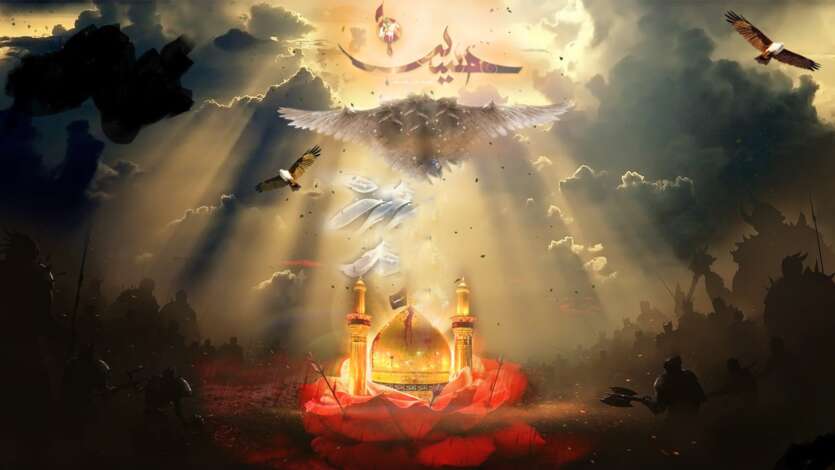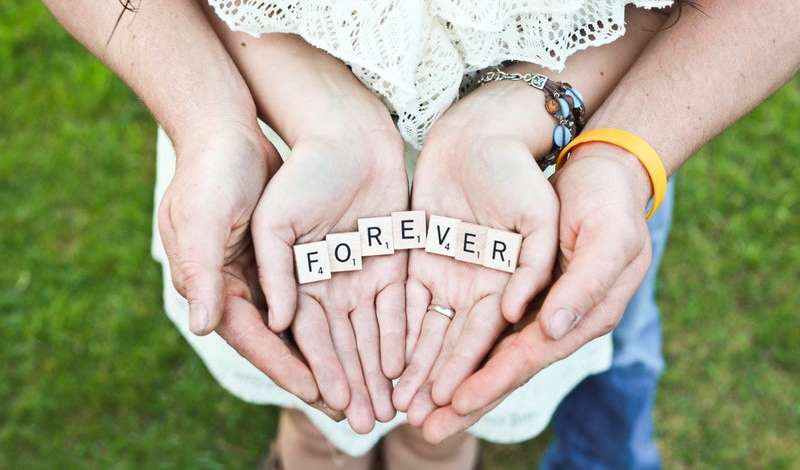The topic of Islamic amulets and talismans is a very broad topic, and I do recommend my brothers and sisters to read into this area, especially to be able to define between this and the topic of magic and myth/superstition.[1]
Before I start explaining about the extremely important hirz of Sharaf al-Shams, let’s understand some of the common terms we use in this field:
- Hirz: This word is used in reference to a prayer, a piece of writing, or an amulet for protection. Its literal meaning is “a fortified container that protects something”.[2] It means to safeguard, fortify, preserve and protect. In the technical usage of this word, it means using a fortified vessel for protection from dangers. A hirz (pl. ahraz) is used to protect oneself against evil eye, misfortunes, and for the gaining of sustenance and health. It is something recited, written or worn. A hirz is usually readable words and sentences.
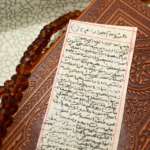
- Ta’widh: Or ta’veez, has a similar meaning to hirz, also meaning seeking protection. This word comes from al-‘awdhah, which means to seek refuge and resort to the Almighty. A ta’veez would be recited,[3] written, or worn for the sake of protection against harm, thieves, wild animals, being scared, and being safe from other things. This term is usually used by Muslims of the Sub-continent.
- Hijab: This term is also used in reference to a hirz or a ta’veez. This term is usually used among Lebanese Muslims.
- Talasm: Written in Arabic as طلسم , its English equivalent is Talisman, coming from the Arabic word and the Greek telesma. In Persian it is pronounced as telesm. The term talisman is a familiar word in the English language, like the term amulet, and it usually a consecrated object used as a charm to bring good luck and banish evil. One view is that طلسم read the opposite way is مسلط, or ‘control’, which means the talisman will ‘control’. In the Islamic tradition a talsam is usually made up of figures or symbols, engraved on a stone.
- Ruqyah: This term (al-ruqyah al-shar’iyah) is usually used among Sunni Muslims, referring to a method of repeated recitation of selected Quranic verses for the purpose of treating illness, evil-eye, Jinn and magic. Ruqyah comes from the word raqa, which means to elevate, and its technical meaning is to resort to God for the purpose of overcoming and elevating over an illness or a problem. An English equivalent for this word would be ‘incantation’.
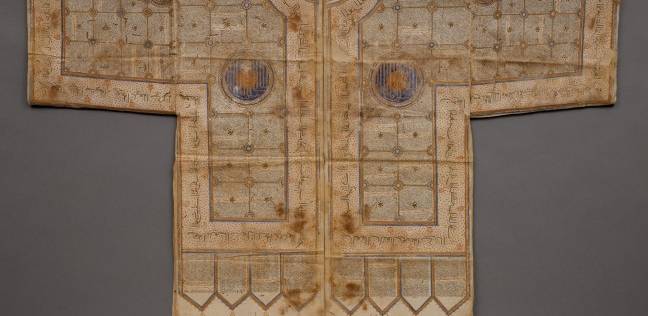
This is an undergarment with talismans written all over it. Usually used for war.
The hirz, or talisman could be an object imbued with protective powers. Whatever the object may be, it would bear inscriptions from the Quran, or evoke names of Almighty Allah, or the Ma’sumeen, or symbols.[4]
Although when you read about this in the English language, you might come across the word magic, in these amulets and talismans having ‘magic powers,’ but we avoid using this word ‘magic’ (sihr) in our Islamic cultural practice, because we know that sihr is haram, and Ahraz and Talasim are not defined as sihr.
This is not to say that we do not have Talasim that are magic, or haram, because some are, but they are not what we are discussing here.
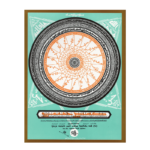
In brief, and after this quick introduction and explaining the terms, I can say that the correct word we should be using for the Sharaf al-Shams is talasm, and not hirz, because the Sharaf al-Shams are figures and symbols, and not words. However, seeing that we all refer to it has a hirz, there is no harm is calling it what people are used to hearing and saying – hirz sharaf al-shams.[5]
What is Hirz Sharaf al-Shams:
Sharaf al-Shams basically means the nobility of the sun. It is called this name because of the time when the talisman is written.
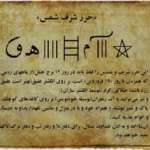
It can only be written in one specific time in the year, on the day when the sun is aligned with Aries (burj al-haml). The Persian date for this would be 19th of Farvardin,[6] or in common calendar it is 8th of April.
The time should be between 11am until 11pm.
It is said that this time is the best time of the alignment between the earth, the sun and the moon.
It is a talisman, attributed to Imam Ali (a.s.), in the form of special symbols and numbers written on yellow paper, deer skin, with yellow ink,[7] or engraved on the back of a yellow agate (‘aqiq) stone. Again this must happen only on this specific date in the year.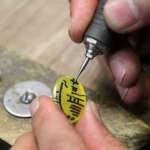
There is also a poem attributed to Imam Ali (a.s.), describing the symbols of the Sharaf al-Shams.[8]
This date also coincides with one of the ancient Iranian festivities celebrated by Zoroastrians.[9]
Another name for it is Talsam Sulaymani, in reference to Prophet Sulayman (a.s.).[10]
There are many other relevant pieces of information that further support the merit and importance of this hirz.
What is Written?
The most common misconception is that the ring, or the stone is called Sharaf al-Shams.
That is not the case. It is the hirz that is called Sharaf al-Shams.
It is said that the special hirz of Sharaf al-Shams contains al-Ism al-A’dham الإسم الأعظم, which is the concealed Greatest Name of Allah ta’ala. The view is that it contains 5 of the Greatest Names of Allah ta’ala.
There is not one unanimous way of writing the hirz, but in general it contains the same symbols. These symbols represent numerological values, that refer to Names of Almighty Allah. Not much more can be said about this, because it is among the many secrets of the universe and the realm of al-Ghayb that we do not have access to.
Some interpretations have been presented, and they might be valid, but in any case what we can deduct is how valuable and powerful this hirz is.
So, in addition to Sharaf al-Shams being a hirz, the ‘Aqiq stone is in itself a hirz and important amulet as well.

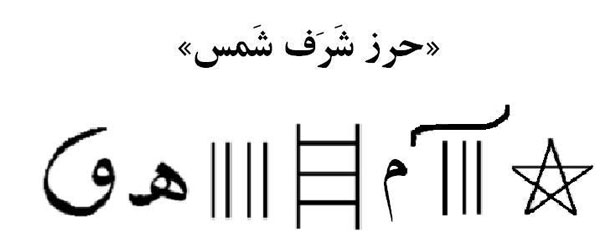
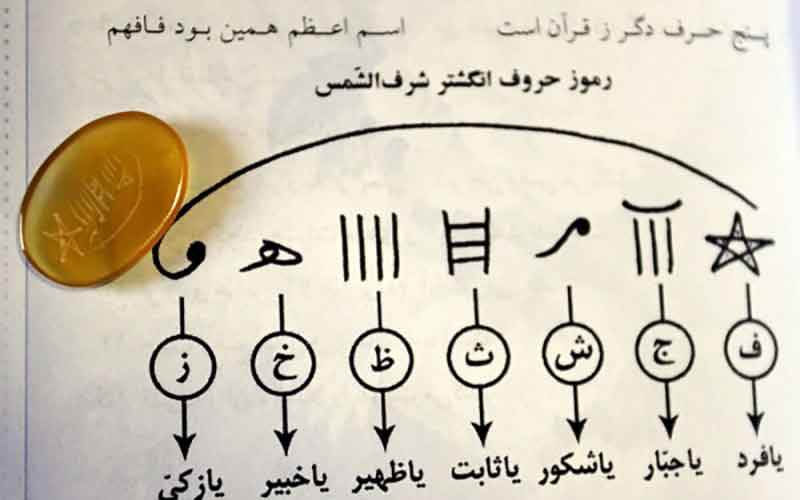
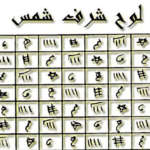


Benefits of Hirz Sharaf al-Shams:[11]
- Banishes sorrow, depression, bad luck, and negativity.
- Repels poverty, illnesses.
- Nullifies magic, and protects you from evil eye and envy.
- Brings you honour and prestige.
- Brings you health and sustenance.
- Increases your wealth and money.
- Protects its holder from evil of humans, jinn and nature.
- Keeps you safe from wild animals.
- Cure insomnia.
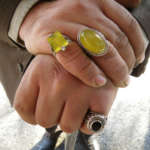
- Will enable you to wake up early, for Fajr prayers, and be an early-riser.
- Living longer life, family happiness and prosperity.
- Gives you spiritual aura and enlightenment.
- Cleanses and eases your blood circulation.
The ‘Aqiq stone itself is very powerful as well. It will keep you safe in trips, it will increase your sustenance, bring you blessings and success, your prayers will be accepted, and evil will be banished from you.
Two very important points I must mention here:
- We must verify that the ahraz we receive or use are authentic, from our Ma’sumeen (a.s.), mainstream Ulama, and reliable books.
- When writing a hirz, and to make it more effective, all the recommended conditions and etiquette must be observed, like being in the state of external taharah, and also internal taharah, with sincerity, purity and piety. This is why when it is written, or authorised by a very spiritual scholar, it would have more effect.
Notes:
[1] One of many English articles you may read is this interesting paper on Amulets, Magic and Talismans:
[2] الحِرْزُ: الوعاء الحصينُ يُحفَظَ فيه الشيء
[3] This is an example of a virtuous oral hirz that can be recited, narrated from Imam Ja’far al-Sadiq (a.s.) [al-Kafi, vol. 4, p. 357]:
أَعُوذُ بِعِزَّةِ اللَّهِ وَأَعُوذُ بِقُدْرَةِ اللَّهِ وَأَعُوذُ بِجَلَالِ اللَّهِ وَأَعُوذُ بِعَظَمَةِ اللَّهِ وَأَعُوذُ بِعَفْوِ اللَّهِ وَأَعُوذُ بِمَغْفِرَةِ اللَّهِ وَأَعُوذُ بِرَحْمَةِ اللَّهِ وَأَعُوذُ بِسُلْطَانِ اللَّهِ الَّذِي هُوَ عَلَى كُلِّ شَيْءٍ قَدِيرٌ وَأَعُوذُ بِكَرَمِ اللَّهِ وَأَعُوذُ بِجَمْعِ اللَّهِ مِنْ شَرِّ كُلِّ جَبَّارٍ عَنِيدٍ وَكُلِّ شَيْطَانٍ مَرِيدٍ وَشَرِّ كُلِّ قَرِيبٍ أَوْ بَعِيدٍ أَوْ ضَعِيفٍ أَوْ شَدِيدٍ وَمِنْ شَرِّ السَّامَّةِ وَالْهـَامَّةِ وَالْعـَامَّةِ وَمـِنْ شـَرِّ كـُلِّ دَابَّةٍ صَغِيرَةٍ أَوْ كَبِيرَةٍ بِلَيْلٍ أَوْ نَهَارٍ وَمِنْ شَرِّ فُسَّاقِ الْعَرَبِ وَالْعَجَمِ وَمِنْ شَرِّ فَسَقَةِ الْجِنِّ وَالْإِنْسِ.
[4] https://www.metmuseum.org/toah/hd/tali/hd_tali.htm
[5] A short but interesting book that has been written on this topic is: Raf’ al-Labs min Sharaf al-Shams, by Sheikh Ali Rashidi Hamadani (Hamadan: Intisharat Tulu’ Gharb, 1396 SY).
[6] Farvardin is the first month of the Iranian Solar Hijri calendar. It is also when the sun is in Aries in its 19th degree of exaltation (sharaf). As Loyd Graham says: “exaltation” in its true sense is a technical term from astrology; its modern/lay translation is usually “honor” or “dignity.”
[7] This yellow ink can be obtained by mixing saffron and rosewater.
[8] I’ve borrowed the translation of this poem in English from the net:
Three sticks in a row after a seal; above them the semblance of a straightened lance
Then a blind ‘mīm’ without a tail, then a ladder unto all that is hoped for, but which is not a ladder
Four things like fingers in a row pointing to good deeds, but without a wrist
And a ‘hā’ that has been split, then an inverted ‘wāw’ like the syphon of a phlebotomist, but not a blood-letting cup
This is the name whose worth is magnified; if you were ignorant of it before, know it now.
O bearer of the Great Name, take sufficiency in it – you shall be preserved from misfortunes and shall be kept safe.
It is the secret name of God, may His glory be glorified, unto all men, be they Arab or non-Arab!
[9] In the book Raf’ al-Labs min Sharaf al-Shams, it explains how numerous traditions speak about Sharaf al-Shams being as ancient as Prophet Sulayman (a.s.), and some of the symbols date back to Prophet Moses (a.s.) and the Torah, and some to Prophet Jesus (a.s.) and the Gospels. [p. 46].
[10] If you would like to further expand on Islamic amulets, seals and talismans, and its relation to older traditions, like Judaism, see Lloyd Graham’s interesting article:
[11] This is also the Dua’ of Sharaf al-Shams:
بسم الله الرّحمن الرّحیم
اَللّهُم اِنّی اَسئَلُکَ بِالهاءِ مِنْ اِسمِکَ الْاَعظَم وبالثَلآثِ العِصّیِ وبالالَفِ المُقّوِّم وبِالمِیمِ الطَمیس الاَبتَر وبالسِّلمِ وبالاَربَعَه الَتِی ه ِی کالکَفِ بِلا مُعصَم وبِالهاءِ المَشقُوقَه وبالواوِ المُعظَّم صوره اِسمکَ الشَّریفِ الاَعظَم اَن تُصَلِیَ علی سَیِّدِنا مُحمَّدِ وَآلِهِ بعدد حروف ماجری بِالقلم واَن تَقضِی حاجَتِی.
![]()

